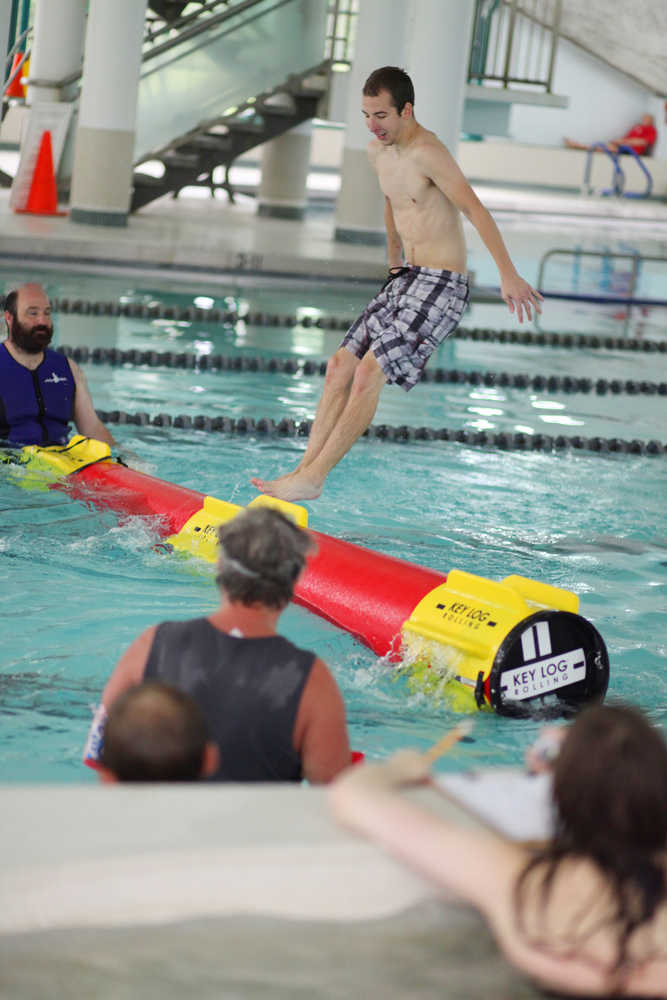Logrolling is not as hard as a looks — at least in the eyes of the group of swimmers at Nikiski Pool training for the aquatic sport.
Nigel LaRiccia, Nikiski Pool supervisor, enlisted a crew of dispatch and lifeguards to help hone footwork and teaching techniques before classes are officially offered at the pool to the public in October.
“It’s a really great activity,” LaRiccia said. “I did it the one time and I was basically hooked. It gets people in the water, it gets people moving, it helps with coordination and balance and it truly is an easy skill to pick up.”
So easy that anyone, with the proper instruction and use of coordination, could be up and rolling in their first session, LaRiccia said. Monday morning was his second day of instructing others to use the Key Log, a hollow, synthetic log that gains weight when filled with water.
Key Logs first came onto the logrolling scene in 2012, conceptualized and created by champion log roller Judy Hoeschler and her family, who believed popularity of the sport was limited by the weight of the lathe-turned wood.
LaRiccia said the Key Log is ideal because it doesn’t rot, require any maintenance and is very portable. He used pool funds to purchase the $1,000 piece of equipment, which will soon be used for classes and maybe hopefully, eventually for onsite and local competitions.
“I always try to get new programs going and offer new programs to the community,” LaRiccia said. “I am trying to start something new and fun and exciting to do.”
Jeremy Ruggiero, 19, has been a lifeguard at the pool for years, working on and off during his summer and holiday breaks from college. He said he missed the first session LaRiccia taught a few weeks ago and was ecstatic he could participate Monday.
He said the exercise takes concentration.
“(You) don’t realize all you need to pay attention to until you fall off four times,” Ruggiero said with a laugh.
The trick, he said, is to hop around the log with your feet as a little as possible. It makes sense, the less the log is touched, the less likely it is to move and throw off the roller, he said.
Celestina Castro, 18, said the sport works the whole body. Arms are active, and outstretched, the torso is flexing and the legs are consistently in motion, squatting or walking, to maintain balance up on the log, she said.
“It takes awhile to get used to,” Castro said.
For beginners, spotters and supporters hold the Key Log steady while rollers embark the temperamental vessel, said lifeguard Lochlan Quiner. Paddles are placed in the middle and on the ends of the log, which slow down the roll, he said.
The group refined their skills Monday by taking timed challenges and battling against one another in one-on-one competitions. During the latter, two people are on the log and must fight to stay rolling the longest.
Quiner said weight actually plays a part in the game, because the heavier an opponent is, the more control they have over where the log goes. He said the social aspect is not one he expected in logrolling, but found out it is a fun way to bond with others.
Elizabeth Oliva had the most success during Monday’s session. She took the title of longest roll, surprising even herself.
“I expected to die a horrible death,” she said with a laugh.
For Oliva, the hardest part was getting up and on the Key Log because the Velcro-like surface of the Key Log is rough on the knees. Other than that it is easy, as long as you learn to fall properly, she said.
It is feet or bottom first, and rollers will only fly far off the log if they purposefully jump outwards, Oliva said.
LaRiccia said anyone in lessons would learn basic safety and rolling skills prior to getting in the water. Safety, posture, coordination, footwork and falling are all essential components to be aware of before starting out, he said.
Right now he is still trying to feel out what age limits he will require for class participation, but at this point the cutoff may be 12. He plans to offer adult, child and joint sessions at the facility.
Reach Kelly Sullivan at kelly.sullivan@peninsulaclarion.com.

